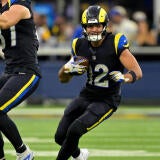NFL Free Agency Fantasy Fallout: Robby Anderson joins Teddy Bridgewater in re-made Carolina passing game
Robby Anderson lands in Carolina where he's not a great fit with presumptive starter Teddy Bridgewater.
One week ago, Carolina reached agreement with Teddy Bridgewater to be their new starting quarterback. Bridgewater is an accurate quarterback with a career completion percentage of 65.2%, but that is in large part due to his willingness to take what the defense gives him and throw underneath.
In other words, it's not the best fit for Robby Anderson, who signed with the Panthers on Tuesday for $20 million over two years. Among quarterbacks with at least 100 dropbacks last season, Bridgewater's average throw depth was lowest at 6.2 yards. Anderson, of course, is a downfield threat, evidenced by a career aDOT of 15.0 and four straight seasons of at least 1,300 air yards to begin his career, including leading Jets wide receivers by at least 400 over each of the past three years.
New Panthers coach Matt Rhule coached Anderson in college at Temple, where Anderson was the top target for two seasons for another newly-signed Panther — breakout XFL star P.J. Walker. There are layers to this signing, and I haven't even gotten to Curtis Samuel, who finished ninth in the NFL in air yards in 2019 and is the first real field stretcher to have shared a field with Anderson.
Let's start with Bridgewater, who comes over from New Orleans and a system that emphasizes easy completions — the Saints rank among the most running back receptions annually, for example. With a low aDOT, Michael Thomas is the type of No. 1 receiver who pushes those statistics into overdrive — over the past three seasons, Drew Brees has the three highest single-season completion percentages in NFL history for quarterbacks who threw at least 200 passes.
Brees also had the second-lowest average throw depth in 2019, behind only Bridgewater, so some degree of Bridgewater's game-managing statistics can be chalked up to the Saints, though that label has followed him to some degree since college. And Bridgewater's been mostly successful operating that way.
Still, it would have been fair to expect him to open things up a bit more anywhere outside New Orleans. And then he landed in Carolina, where Christian McCaffrey and D.J. Moore might be the league's best doppelganger tandem for Kamara and Thomas, and Carolina's new coaching staff features offensive coordinator Joe Brady, the oft-praised passing game coordinator for LSU's title run last year. Dave Richard broke down Brady's system earlier this offseason and mentioned Joe Burrow's relatively low percentage of deep passes in his writeup of the prospect. The Cliff's Notes are that Brady's spread system needs an accurate quarterback, and that makes Bridgewater seem like a great fit.
But there was reason to hope for a rebound for Samuel, as well, given his incredibly low 63% catchable target rate in 2019 that could reasonably be chalked up to Kyle Allen's struggles down the field. That led to Samuel finishing with just 627 receiving yards as the only receiver in the top 15 of total air yards to not record a 1,000-yard season.
It seems unlikely all of Samuel's downfield volume will magically dry up, which at first blush means splitting some of what could be limited downfield work. But there's another complication here — Anderson is an outside receiver, and last year Moore (15.7% slot rate, per PFF) and Samuel (28.1%) were both primarily outside receivers, too, while Jarius Wright was the main slot guy. Replacing Wright with Anderson in three-wide sets isn't cut and dry, and it's not clear whether Moore would move from the X role to the Z and Samuel from the Z to the slot, or if perhaps Moore would move inside more often.
Further complicating this, Samuel does have a history of playing nearer to the line of scrimmage at Ohio State, where he racked up 172 carries and 107 catches across three seasons while playing both receiver and running back. Samuel fits as a move receiver in the Z role, but then so does Moore with his versatility. Brady and Rhule will have all sorts of options as they start to design their offense.
What's easiest to parse is the challenge of all these players hitting their prior air yards numbers, at least while Bridgewater is under center. However, in the off chance Walker plays some this year, his five-game sample in the XFL featured a lot more downfield passing, and from a style perspective, he's the type of quarterback who would fit Anderson's strengths. The aforementioned Rhule-Walker-Anderson Temple connection will certainly be brought up more this offseason.
The most likely outcome here is Bridgewater under center, which remains a great fit for McCaffrey and Moore given the depths at which they see their targets. It could be an improvement for Samuel, as well, if his role changes, but the air yards overlap between he and Anderson make it difficult for me to see either being a bit Fantasy contributor. The Anderson addition also hurts the breakout case for Ian Thomas after Greg Olsen left town, and with a ton of similar late-round tight end plays, I'll likely be avoiding Thomas in favor of names like Blake Jarwin, Jace Sternberger and Jonnu Smith when I wait at the position.
















